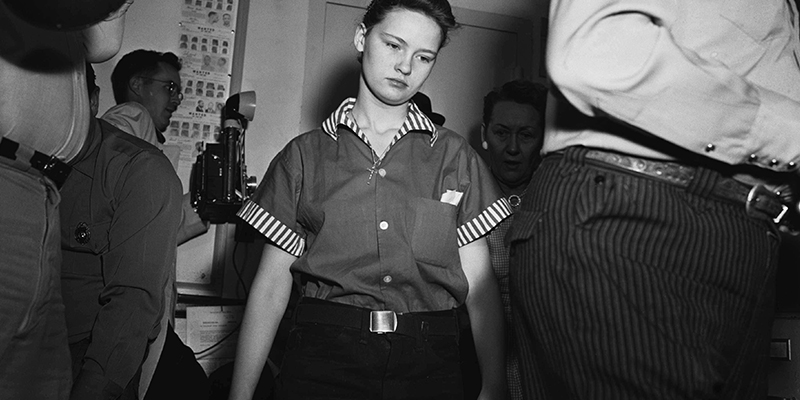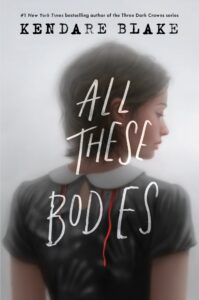On January 21, 1958 in Belmont, Nebraska, 19-year-old Charlie Starkweather shot and killed 14- year-old Caril Ann Fugate’s mother and stepfather, and stabbed and beat her two-year-old baby sister to death. In the eight days that followed, seven more people would die along the route of Starkweather and Fugate’s sex-fueled teenage crime spree, including two fellow teenagers—Robert Jensen and Carol King—whose murders would eventually land Charlie on death row, and Caril in a Nebraska penitentiary for life.
It looked like a 1950s version of Bonnie and Clyde: two young criminals on the run, fed up with the straight and narrow of school and small town jobs, looking to ride into the sunset in a blaze of glory. To Caril, Charlie was a James Dean stand-in, the older boy with the cool coat and a cigarette perpetually hanging from his bottom lip. To Charlie, Caril was his girl, younger than he was and pretty.
They were two kids from the wrong side of the tracks, whose love story ended in violence and bloodshed, and inspired films starring major Hollywood players, and even a song by Bruce Springsteen.
I grew up in a small town in rural Minnesota, and movies like Murder in the Heartland (starring Tim Roth and Fairuza Balk in the Starkweather and Fugate roles) and Oliver Stone’s Natural Born Killers (Woody Harrelson and Juliette Lewis in inspired-by depictions) made sure I was familiar with the case from an early age. I was fascinated in particular by Caril: fourteen, about the same age as I was at the time I learned about the murders. Caril has always maintained her innocence, stating that she was Starkweather’s hostage. That she didn’t know her family was already dead, and the only reason she participated in the crimes—holding a gun on a victim, or helping Charlie to acquire supplies—was because she was ordered to, and was terrified that if she disobeyed or tried to get away, Charlie would place a call to his gang back in Belmont and they would kill her family.
Caril Ann Fugate was convicted as a willing accomplice, but I always wondered whether that was really the case. It seemed a hell of a thing, for a 14-year-old girl to embark on, especially when she swore she’d broken up with Charlie the week before. She said she was scared. She said that she and Charlie never done anything more than French kiss. But nobody seemed to believe her.
Historically, violent crimes committed by women have always required an explanation: how could a woman deviate so far from normal, expected feminine behavior? And the explanation boiled down to three possibilities. Was she bad, sad or mad? If she could be shown to be any of those things, then the crime began to make sense. She was not the feminine ideal, she was the woman scorned, the crazy woman, the promiscuous woman who was no good from the start. In Caril’s case, maybe she was all three.
Immediately after her arrest, newspaper reports about Caril Ann Fugate were sympathetic and even flattering, featuring quotes from neighbors who described her as “sweet and kind” and expressed disbelief that she could have played a part in any of the crimes. But as interest in the trials increased, so did public hunger for salacious details and sensational articles. The papers’ characterization of Caril changed from flattering, to depicting her as having a pouty face and angry eyes. They said she was often petulant, and headlines ran across the country with titles like, “Caril Reserved, Emotionless” or “Smiling Caril Breaks Down”, further separating her from the feminine ideals that would have garnered her sympathy. Women and girls were supposed to be emotional. They were supposed to be timid and afraid and should not smile in the face of a criminal trial.
The reporters who covered the story were later quoted as saying they felt sure by their impressions of Caril that she was at least a willing participant, if not an actual killer. She was old for fourteen, they said. And she had committed every sex act in the book.
They had sex every day and twice on Sundays, Charlie Starkweather liked to say. They spent the days following the murder of her family holed up in her family home “watching tv and having sex”. Immediately following his arrest, he told officers that Caril had nothing to do with the murders. But later he would tell them that she killed two: all girls.
Charles Starkweather served as the prosecution’s star witness in Caril’s trial, and coverage of Starkweather’s testimony in the papers suggested that his account of the killings had “nailed shut the last cracks” in Caril’s defense. Caril testified on her own behalf but it seemed to do more damage than good: she was confused, there were lapses in her memory—she was aggressive, not penitent enough. But it wouldn’t have mattered had she been solid as a rock. There were no real witnesses to the crimes—everyone who had been there was dead. And in the case of he said/she said, Charlie—despite having changed his story several times—gave the jury the explanation they were most able to believe. Caril Ann Fugate was a very bad girl. She was convicted of first-degree murder and sentenced to life in prison.
To anyone following the papers, the verdict would have seemed inevitable—articles continued to be written with the presumption of guilt, and often mischaracterized witness testimony—in the court of public opinion, Caril had been convicted long ago. It’s easy to disbelieve the accounts of girls and young women—or simply to believe the worst of promiscuous ones. So easy that Charlie Starkweather—at best a murderer and at worst a jilted ex—was deemed a more credible source of the truth.
Caril Ann Fugate was emotionless. Except that during the days following the end of the crime spree she was often so upset that she had to be sedated. Caril was worldly, and had sex often. Except she testified that Charlie struggled with impotence (something that at fourteen she didn’t seem to fully understand) and a physical examination showed her hymen to be intact, making intercourse unlikely. She should have known what to do, when the murders happened! She should have known how to get away.
Had Charlie Starkweather not been Caril’s boyfriend, but instead a stranger, would the perception of her guilt be different? Could we then view her as a teenager, barely more than a child, operating out of shock and fear?
Maybe. Or maybe not. Even years later, those associated with the case seem mostly frustrated with Caril’s continued assertion of her innocence. They’re disappointed that she has stood by her story instead of just admitted guilt and been contrite. But since she hasn’t, the truth of the events of January 1958 remain unknown. Charlie is dead, executed in the electric chair on June 25, 1959, with the public believing that Caril Ann Fugate committed the crimes right alongside him. And why wouldn’t they? She had angry eyes, and a pouty face.
She was fourteen. But she was an old fourteen.
***


















